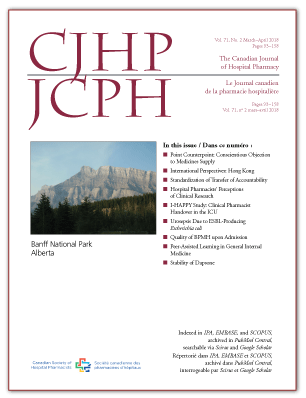Improving the Clinical Pharmacist Handover Process in the Intensive Care Unit with a Pharmacotherapy-Specific Tool: The I-HAPPY Study
DOI:
https://doi.org/10.4212/cjhp.v71i2.1861Keywords:
clinical handover, intensive care, pharmaceutical care, pharmacist, transfert clinique, soins intensifs, soins pharmaceutiques, pharmacienAbstract
ABSTRACT
Background: Pharmacists in the intensive care unit (ICU) provide pharmaceutical care to critically ill patients. Identification and resolution of drug therapy problems improves outcomes for these patients. To maintain continuity of care, pharmacotherapy plans should be transferred to a receiving pharmacist upon discharge of patients from the ICU. No previous studies have addressed the development or evaluation of a systematic, standardized clinical handover tool and process for pharmacists.
Objectives: To assess pharmacists’ satisfaction with and utilization of a pharmacotherapy-specific handover tool and process.
Methods: Plan–do–study–act methodology was employed to develop a clinical handover tool and process, which were implemented in a Canadian health authority. For evaluation of the tool and process, a multicentre, online survey questionnaire was distributed to 14 clinical pharmacists in the ICU and ward settings at 5 hospitals between February 15 and April 22, 2016.
Results: Thirteen of the pharmacists completed the survey. All 13 pharmacists (100%) were satisfied with usability; 12 (92%) were satisfied with training, organization, and accuracy of the process; and 11 (85%) were satisfied with completeness and efficiency. Most pharmacists conducted 1 or 2 handovers per week, with each having a duration of 3–5 min. Seven (54%) of the respondents reported that they communicated handovers mostly or exclusively by telephone, and 6 (46%) reported using mostly or exclusively face-to-face communication. However, 6 (46%) reported a preference for face-to-face communication, and 3 (23%) reported a preference for the telephone; the remaining 4 (31%) had no preference for mode of communication.
Conclusions: Respondents were highly satisfied with the handover tool and process. ICU pharmacists appeared more satisfied with the training, organization, and completeness of handover, whereas ward pharmacists appeared more satisfied with the accuracy and efficiency of handover. Workload requirements were minimal, and face-to-face interaction, although slightly less well utilized than the telephone, was the preferred method of communication.
RÉSUMÉ
Contexte : Les pharmaciens exerçant dans les unités de soins intensifs (USI) prodiguent des soins pharmaceutiques aux patients gravement malades. Or, déceler et résoudre les problèmes pharmacothérapeutiques améliore les résultats cliniques pour ces patients. Afin de maintenir la continuité des soins, les plans pharmacothérapeutiques doivent être communiqués au moment du congé des patients de l’USI à un autre pharmacien qui prendra ensuite le relais. Aucune étude n’avait auparavant étudié la mise au point ou l’évaluation d’un outil et d’un processus normalisés de transfert des soins à être utilisés systématiquement par les pharmaciens.
Objectifs : Évaluer le taux de satisfaction des pharmaciens à l’égard d’un outil et d’un processus destinés au transfert des soins pharmacothérapeutiques et en analyser leur utilisation.
Méthodes : La méthodologie planifier-exécuter-étudier-agir a été employée pour mettre au point un outil et un processus de transfert clinique introduits dans une régie de santé canadienne. Afin d’évaluer l’outil et le processus, un sondage en ligne a été présenté à 14 pharmaciens cliniciens travaillant soit dans les USI soit dans d’autres services intrahospitaliers de 5 hôpitaux, entre le 15 février et le 22 avril 2016.
Résultats : Treize pharmaciens ont rempli le sondage. Les 13 (100 %) étaient satisfaits de la facilité d’emploi; 12 (92 %) étaient satisfaits de la formation, de l’organisation et de l’exactitude du processus; et 11 (85 %) étaient satisfaits du degré d’exhaustivité et de l’efficacité. La plupart des pharmaciens réalisaient 1 ou 2 transferts par semaine, chacun d’une durée de 3 à 5 minutes. Sept (54 %) répondants ont indiqué qu’ils communiquaient les transferts surtout ou seulement par téléphone et 6 (46 %) ont dit le faire surtout ou uniquement en personne. Or, 6 (46 %) ont indiqué une préférence pour la communication en personne et 3 (23 %) ont dit préférer la voie téléphonique. Les 4 (31 %) autres étaient indifférents au mode de communication utilisé.
Conclusions : Les répondants étaient grandement satisfaits de l’outil et du processus de transfert. Les pharmaciens exerçant dans les USI semblaient plus satisfaits de la formation, de l’organisation et du degré d’exhaustivité du transfert alors que les pharmaciens travaillant dans d’autres services intra-hospitaliers semblaient plus satisfaits de l’exactitude et de l’efficacité du transfert. La charge de travail était minimalement accrue et la communication en personne, bien qu’utilisée moins fréquemment que celle par téléphone, était le mode préféré.
Downloads
Published
Issue
Section
License
Copyright © Canadian Society of Healthcare-Systems Pharmacy.
After publication of a manuscript in the CJHP, the authors of the manuscript must obtain written permission from the CSHP (publications@cshp.ca) before reproducing any text, figures, tables, or illustrations from the work in future works of their own. If a submitted manuscript is declined for publication in the CJHP, all said rights shall revert to the authors. Please note that any forms (e.g., preprinted orders and patient intake forms) used by a specific hospital or other health care facility and included as illustrative material with a manuscript are exempt from this copyright transfer. The CJHP will require a letter from the hospital or health care facility granting permission to publish the document(s).










